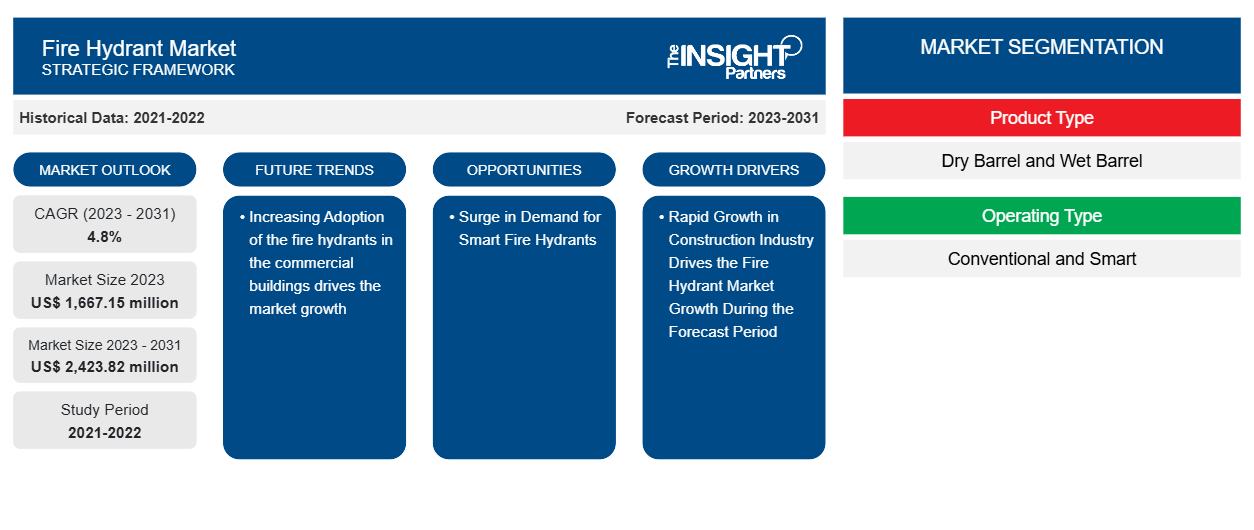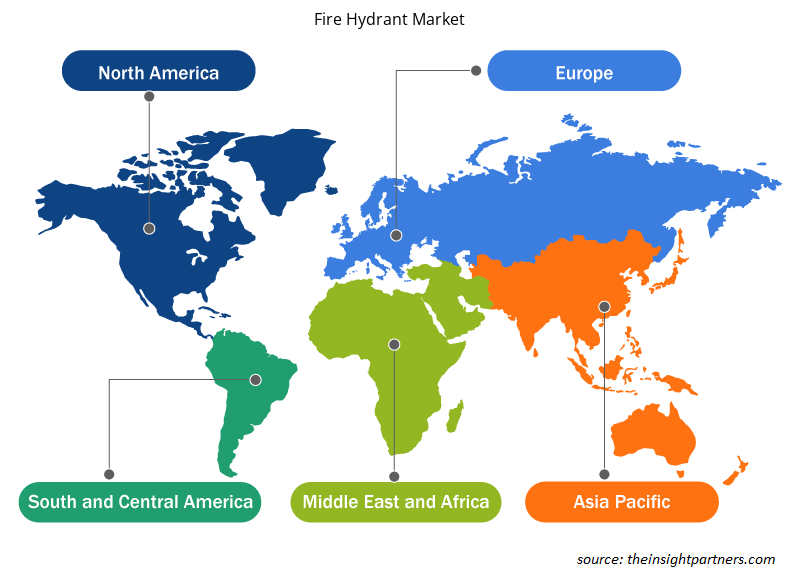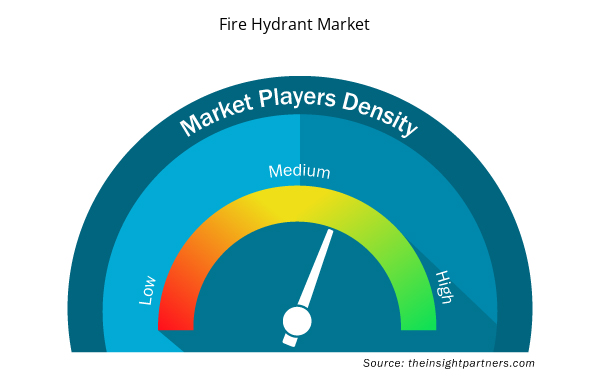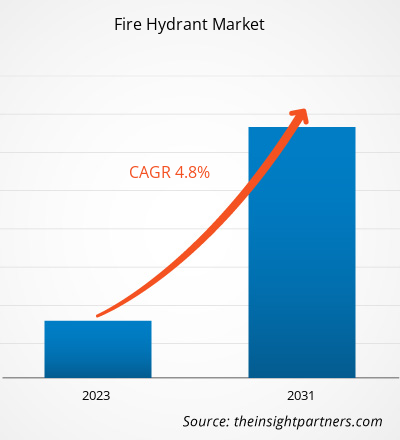The Fire Hydrant market size is projected to reach US$ 2,423.82 million by 2031 from US$ 1,667.15 million in 2023. The market is expected to register a CAGR of 4.8% in 2023–2031.
Fire Hydrant is an exclusive storage facility used to store temperature-sensitive goods or products, often perishable items, including frozen foods, fresh produce, and pharmaceutical products. Fire Hydrant facilities help to ensure the integrity, freshness, and safety of perishable products.
The rising consumer preference for processed and easy-to-cook canned food boosts the demand for Fire Hydrant facilities. In addition, the growing adoption of omnichannel grocery shopping and the proliferation of online shopping are also benefitting the Fire Hydrant market globally. Consumers are considering online shopping for groceries as it is safe and helps save time. The booming food & beverages sector, due to growing demand for canned and frozen food products, along with development in the pharmaceutical sector, is also propelling the global fire hydrant market.
Fire Hydrant Market Analysis
The market growth is ascribed to the surge in urbanization and commercial and industrial buildings along with widespread awareness regarding asset protection. The rise in government regulations encouraging the installation of fire protection systems in residential and non-residential buildings is likely to catalyze the fire hydrant market expansion in the coming years. In smart fire hydrants, sensors, or artificial intelligence (AI) can be used to control the systems.
Fire Hydrant Market Overview
Fire hydrant systems are critical tools that are needed in various companies or manufacturing plants to extinguish a fire. A fire hydrant system consists of a water-pressurizing system dispersed throughout the structure via pipes and hoses. These systems include water storage tanks, pumps, pipelines and valves, fire brigade boosters, hydrant, landing valves, coupling, lay-flat fire hoses, and block plans. The principle of pressure drop governs the operation of fire hydrant systems. The water pressure drops when the operator opens the hydrant valve. The pressure switch activates the booster pump to counteract this effect, which takes more water from the source to raise the system's pressure. This pressurized water, with 7–10 bar pressures, is then directed to the origin of the fire to put it out. The fire hydrant systems are classified on the basis of their drive configurations, such as diesel, electric, and hybrid drive systems. The diesel, electric, and hybrid drive models use diesel, electricity, and a combination of both as fuel, respectively, for the operation of the fire hydrant system. Further, these systems can be made much more effective by automating them, as one or two people are always required to handle a fire hydrant system.
Customize This Report To Suit Your Requirement
You will get customization on any report - free of charge - including parts of this report, or country-level analysis, Excel Data pack, as well as avail great offers and discounts for start-ups & universities
Fire Hydrant Market: Strategic Insights

- Get Top Key Market Trends of this report.This FREE sample will include data analysis, ranging from market trends to estimates and forecasts.
Customize This Report To Suit Your Requirement
You will get customization on any report - free of charge - including parts of this report, or country-level analysis, Excel Data pack, as well as avail great offers and discounts for start-ups & universities
Fire Hydrant Market: Strategic Insights

- Get Top Key Market Trends of this report.This FREE sample will include data analysis, ranging from market trends to estimates and forecasts.
Fire Hydrant Market Drivers and Opportunities
Rapid Growth in the Construction Industry Drives the Fire Hydrant Market Growth During the Forecast Period
The growth of the fire hydrant market is attributed to the rapidly growing construction industry with the growing global population and urbanization. The countries, including Mexico, the US, Canada, Germany, and France, have shown significant investments in new construction and infrastructure development projects with government support and initiatives. Rising in construction work across residential, and commercial sectors owing to growing urbanization is driving the growth of the fire hydrant market growth.
The global market for residential buildings including new construction, renovation buildings, and remodeling, was valued at US$ 6.80 trillion in 2022 according to the Ceramics Organization Report. Government bodies are putting additional emphasis on strengthening construction and infrastructural development, which is further enduring the demand for the fire hydrant market. As per the Global Construction 2030, it is estimated that the volume of construction output will increase by 85% to US$ 15.5 trillion by 2030 worldwide. The US, Japan, and India are contributing to have the largest share and are growing with the highest CAGR during the forecast period. Moreover, investment to renovate old buildings and structures and increasing government rules and regulations towards safety of the buildings, which is further nurturing the fire hydrant market growth.
Surge in Demand for Smart Fire Hydrants
Smart fire hydrants allow water management to stay ahead of the problems by offering a complete picture of their distribution networks. With this knowledge, utilities may save money by preventing issues and gaining customer loyalty by making their lives easier. The smart hydrant can save money by detecting leaks significantly more rapidly and efficiently than current approaches. Even though utilities regularly monitor known trouble sites like major junctions, a minor leak can go undetected for long periods until it gets large enough to interrupt water pressure, erode pavement, or trigger a significant pipe break. A smart hydrant can enable system-wide monitoring daily. Allowing leak detection staff to work more efficiently can also help the utility lower its carbon footprint. Unauthorized hydrant openings can also be detected by smart hydrants, which can inform utilities. Smart fire hydrants could make a substantial dent in the amount of water wasted due to utility system leaks, but there is still the matter of individual water use to consider.
Fire Hydrant Market Report Segmentation Analysis
Key segments that contributed to the derivation of the fire hydrant market analysis are product type, operating type, construction, and application.
- Based on the product type, the market is divided into dry barrel and wet barrel. The dry barrel dominates the market due to increasing adoption in areas with freezing temperatures. Also, the protection rusts and reduced maintenance requirement compared to the wet barrel are augmenting the segment growth. However, the low price of a wet barrel fire hydrant and easy access in normal atmospheric temperature conditions support its growth. Adopting the dry and wet barrels fire hydrants is majorly dependent upon the environmental condition requirements.
- Depending upon the operating type, the market is divided into conventional and smart. Conventional fire hydrants dominate the market due to deep penetration in the market. However, increasing demand for water data monitoring is accelerating growth in the smart fire hydrant segment.
- Based on construction, the market is divided into underground and above-ground.
- Depending on the end user, the global fire hydrant market is divided into commercial and industrial.
Fire Hydrant Market Share Analysis by Geography
The geographic scope of the Fire Hydrant market report is mainly divided into five regions: North America, Asia Pacific, Europe, Middle East & Africa, and South America/South & Central America.
Asia Pacific comprises developing economies such as China, India, Singapore, and Vietnam, along with other southeast countries, and developed economies such as Japan and Australia. The manufacturing industries in Asian countries are expanding exponentially. Furthermore, rising investments in the construction industry from government bodies of India, China, and other Asia Pacific countries will accelerate the growth of industrial, residential, and commercial sectors, thereby creating significant growth opportunities for the fire hydrant market players.
Fire Hydrant Market Regional Insights
Fire Hydrant Market Regional Insights
The regional trends and factors influencing the Fire Hydrant Market throughout the forecast period have been thoroughly explained by the analysts at Insight Partners. This section also discusses Fire Hydrant Market segments and geography across North America, Europe, Asia Pacific, Middle East and Africa, and South and Central America.

- Get the Regional Specific Data for Fire Hydrant Market
Fire Hydrant Market Report Scope
| Report Attribute | Details |
|---|---|
| Market size in 2023 | US$ 1,667.15 million |
| Market Size by 2031 | US$ 2,423.82 million |
| Global CAGR (2023 - 2031) | 4.8% |
| Historical Data | 2021-2022 |
| Forecast period | 2023-2031 |
| Segments Covered |
By Product Type
|
| Regions and Countries Covered | North America
|
| Market leaders and key company profiles |
Fire Hydrant Market Players Density: Understanding Its Impact on Business Dynamics
The Fire Hydrant Market market is growing rapidly, driven by increasing end-user demand due to factors such as evolving consumer preferences, technological advancements, and greater awareness of the product's benefits. As demand rises, businesses are expanding their offerings, innovating to meet consumer needs, and capitalizing on emerging trends, which further fuels market growth.
Market players density refers to the distribution of firms or companies operating within a particular market or industry. It indicates how many competitors (market players) are present in a given market space relative to its size or total market value.
Major Companies operating in the Fire Hydrant Market are:
- American Cast Iron Company
- AVK International A/S
- BOCCIOLONE ANTINCEDIO
- EJ Group, Inc
- IMP Armature d.o.o
- Kupferle Foundry Company
Disclaimer: The companies listed above are not ranked in any particular order.

- Get the Fire Hydrant Market top key players overview
Fire Hydrant Market News and Recent Developments
The Fire Hydrant market is evaluated by gathering qualitative and quantitative data post primary and secondary research, which includes important corporate publications, association data, and databases. The following is a list of developments in the market for innovations, business expansion, and strategies:
- In March 2024, The Public Service Commission of the US West Virginia launched task force for addressing defective fire hydrants as three fire hydrants were failed to deliver water in the Charleston house that burned down. The homeowners filed lawsuit against water utility West Virginia American Water. (Source: Eurofins, Press Release)
- In June 2022, AVK Holding Company completed the acquisition of TALIS Group based in the UK. The company manufactures fire hydrant and other construction Equipments that operates as Atlantic Plastics Ltd.
Fire Hydrant Market Report Coverage and Deliverables
The “Fire Hydrant Market Size and Forecast (2021–2031)” report provides a detailed analysis of the market covering the following areas:
- Fire Hydrant Market size and forecast at global, regional, and country levels for all the key market segments covered under the scope
- Market dynamics such as drivers, restraints, and key opportunities
- Fire Hydrant Market Trends
- Detailed PEST Analysis and SWOT analysis
- Fire Hydrant Market Analysis covering key market trends, global and regional framework, major players, regulations, and recent market developments.
- Fire HydrantMarket Industry landscape and competition analysis covering market concentration, heat map analysis, prominent players, and recent developments.
- Detailed Company Profiles
- Historical Analysis (2 Years), Base Year, Forecast (7 Years) with CAGR
- PEST and SWOT Analysis
- Market Size Value / Volume - Global, Regional, Country
- Industry and Competitive Landscape
- Excel Dataset


- Public Key Infrastructure Market
- Hydrogen Compressors Market
- Precast Concrete Market
- Biopharmaceutical Contract Manufacturing Market
- Small Internal Combustion Engine Market
- Energy Recovery Ventilator Market
- Sleep Apnea Diagnostics Market
- Thermal Energy Storage Market
- Dairy Flavors Market
- Workwear Market

Report Coverage
Revenue forecast, Company Analysis, Industry landscape, Growth factors, and Trends

Segment Covered
Product Type, Operating Type, and End User

Regional Scope
North America, Europe, Asia Pacific, Middle East & Africa, South & Central America

Country Scope
Argentina, Australia, Brazil, Canada, China, France, Germany, India, Italy, Japan, Mexico, Russian Federation, Saudi Arabia, South Africa, South Korea, United Arab Emirates, United Kingdom, United States
Frequently Asked Questions
North America is expected to dominate the fire hydrant market in 2023.
Rapid growth in construction industry drives the fire hydrant market growth during the forecast period.
Increasing Adoption of the fire hydrants in the commercial buildings drives the market growth
American Cast Iron Company; AVK International A/S; BOCCIOLONE ANTINCEDIO; EJ Group, Inc; IMP Armature d.o.o; Kupferle Foundry Company; McWane International; Mueller Co. LLC.; NEWAGE FIRE PROTECTION SERVICES PVT. LTD; and Rapidrop Global Ltd.
Fire hydrant market size is projected to reach US$ 2,423.82 million by 2031 from US$ 1,667.15 million in 2023.
The market is expected to register a CAGR of 4.8% in 2023–2031.

 Get Free Sample For
Get Free Sample For